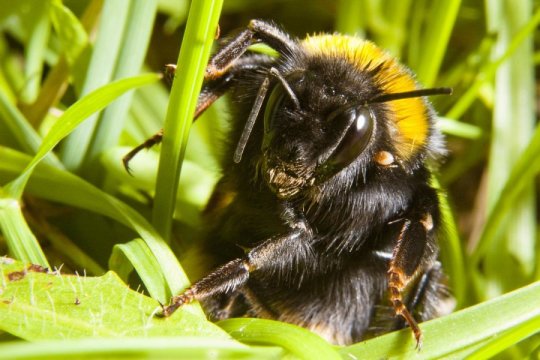[ad_1]
Scientists at Queen Mary University of London have discovered a never before reported behaviour of queen bumblebees.
It was long thought that queen bumblebees, after hibernating in the ground over winter, emerged, began feeding and dispersed quite quickly to found their new colony.
But new research shows that directly after hibernation, queen bumblebees spend the majority of their time hiding and resting amongst dead leaves and grass.
The study, published in the journal Scientific Reports, suggests that this behaviour of long rests with short intermittent flights explains how queen bumblebees find themselves far away from their natal nest.
Dr James Makinson, who co-led the study at Queen Mary University of London but is now based at Hawkesbury Institute for the Environment at Western Sydney University, said: “We wanted to see what queens actually do right after they emerge. By combining state-of-the-art tracking technology with wild bee observations, we were able to uncover a never before seen behavior of queen bumblebees.”
The researchers placed small antenna on the backs of queens that had just emerged from artificially induced hibernation. At an outdoor field site, radar was used to track the bees via the antennae as they woke up and left the area.
The data showed that the queens were spending most of their time on the ground (between 10-20 minutes on average) and making short flights (10-20 seconds on average) in nearly random directions. Observations of wild queen bumblebees verified this was not due to the antennas but rather natural behaviour of recently emerged queens. Computer modelling also showed that this behaviour can explain how bees end up many kilometres from the hibernation spots.
Dr Joe Woodgate, a co-lead author of the study from Queen Mary University of London, said: “Our study suggests that a few weeks of this type of behaviour would carry queen bees several kilometers away from their hibernation site and might explain how queens disperse from the nest in which they were born to the place they choose to found a new colony.”
Dr Makinson added: “Better understanding the behavior of queens during this crucial period of their lives can suggest practices to improve their chances of successfully founding new colonies and help their survival.
“Our findings suggest that creating pollinator friendly corridors between conserved landscape patches would be helpful. It would also be beneficial to plant pollinator friendly flowers and trees all year round, giving bumblebee queens ample access to food during their early spring emergence. And leaving vegetation, such as leaf litter and long grass, undisturbed until late in the spring would give queen bumblebees safe places to rest.”
If you see an exhausted bumblebee queen around this time of the year, researchers suggest you can rescue her by giving her sugar solution (half water, half sugar, thoroughly stirred). Put the solution on a teaspoon and move the spoon gently to near her antennae or mouthparts. Drinking the solution will allow the bee to warm up its flight motor and have sufficient energy to find flowers on its own.
Story Source:
Materials provided by Queen Mary University of London. Note: Content may be edited for style and length.
[ad_2]















